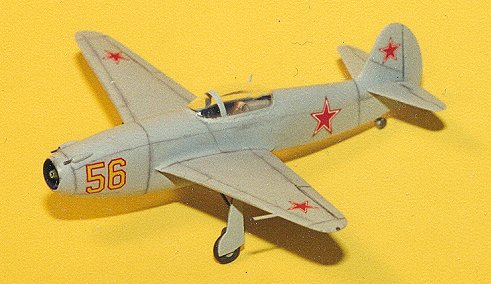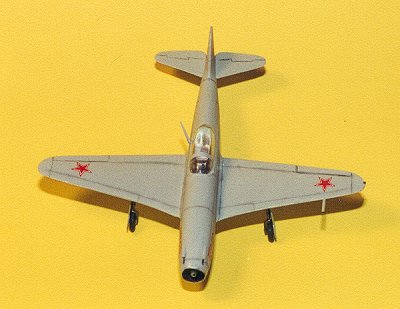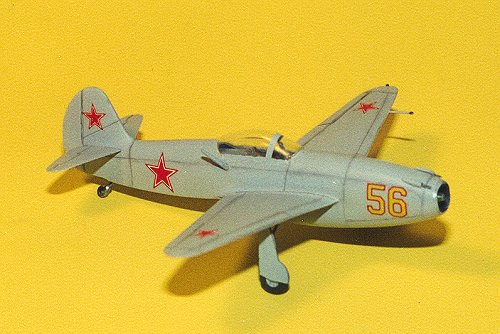
Pioneer 1/72 Yakovlev YAK-15 “Feather”
PRICE: $6.98
KIT NUMBER: None Given
DECALS: Markings for two aircraft: “Yellow 20” and “Yellow 56” of the Soviet Air Force.
DATE OF REVIEW: December 4, 1998
REVIEW & PHOTOS BY: Drew Nix

The Russians knew that they were lagging behind the other major combatants of the Second World War in the development of the jet-powered airplane. Using data from captured German engineers and equipment, they hurriedly combined the airframe of the Yak-3U with the new German Junkers Jumo 004 jet engine. The result was basically a Yak-3 with a jet engine slung beneath it. It was still a “tail-dragger” which caused some problems later on. The Russians quickly found that the rubber tail wheel of the production Yaks could not stand the intense temperatures generated by the jet exhaust. The tail wheel was replaced by a metal roller with a small shield in front of it.
The Yak-15 flew for the first time on April 16, 1946. Well liked by its pilots, it retained the maneuverability of the earlier, piston-engined Yaks. Realizing that this was only a stop gap aircraft, the Russians began working on more sophisticated designs. The Yakovlev Company developed the Yak-17 and Yak-23 as follow-ons to the Yak-15, each having a tricycle landing gear and successively updated copies of the Jumo 004, which the Russians designated RD-10. Only about 300 Yak-15’s were built before construction switched to the Yak-17. Eventually, the much superior MiG-15 made all other then current Soviet fighters obsolete.
 This
kit was purchased because of its unusual subject matter. Tail-dragging
jets were not common (for obvious reasons!). The Pioneer 2 kit is VERY basic.
You get 20 parts molded in tan styrene and a clear, one-piece canopy.
Panel lines are raised, but petite. Sink holes are apparent on the fuselage
and on the one-piece wings. These are easily filled and sanded. The overall
fit of this kit was surprisingly good, with filler only being required on
the wing roots (a lot) and a few spots on the fuselage.
This
kit was purchased because of its unusual subject matter. Tail-dragging
jets were not common (for obvious reasons!). The Pioneer 2 kit is VERY basic.
You get 20 parts molded in tan styrene and a clear, one-piece canopy.
Panel lines are raised, but petite. Sink holes are apparent on the fuselage
and on the one-piece wings. These are easily filled and sanded. The overall
fit of this kit was surprisingly good, with filler only being required on
the wing roots (a lot) and a few spots on the fuselage.
The instruction sheet is on a 5” X 7 1/2” piece of paper! Exploded view drawings without text make up the four steps. In step 1, the basic interior, intake cone, and exhaust cone are trapped between the fuselage halves. The cockpit consists of a floor with rudder pedals and a seat molded into it. The seat looks like a big, comfy easy chair. If this is accurate, and I have my doubts, then the Russians probably couldn’t wait to climb into the cockpits of their mounts just to relax! I added seat belts made of masking tape with silver paint used for the buckles. The kit does include a control stick, but has no instrument panel. I added a panel made from sheet styrene. A spare ESCI decal for a T-33 was cut to shape and added to the panel to represent the instruments. I also added stringers and longerons to the fuselage sides using styrene strip and microfine solder. To this was added a throttle quadrant and various shapes to spruce up the rather spartan interior. The engine intake piece was missing from my kit. I made a substitute from a piece of vac-formed styrene that had been stretched over the intake cone from an OEZ/ESCI 1/48 scale SU-7. The whole interior was painted a medium gray, except for the “easy chair” which was painted leather. A wash of Payne’s Gray was used over the interior, then it was drybrushed with lighter shades of gray and leather.
In step 2, the wings, tailplanes, cannon, cockpit canopy, and antenna post
are added. The wings need a lot of work to get the dihedral correct. Doing
this leaves large gaps at the wing/fuselage joins. MUCH filling and sanding
had to be done here to get everything correct. Masking the one-piece
canopy for painting is nearly impossible given the lightly etched lines that
represent the frames. I used the old standby--clear decal paper painted the
correct shade, then cut into strips and applied to the canopy. For this reason,
I suggest leaving the canopy off until the rest of the aircraft has been
painted, decaled, and sealed. I also left off the antenna post for fear of
breaking it off during construction. The 23mm cannon are molded in with their
fairings. It would take very tiny hypodermic tubing to replace them in this
scale, so the kit provided armament was used.

The next step is adding the main gear, the main gear covers, and the tail roller. The gear is very petite, as are the gear doors. The wheel wells are too shallow and totally lacking in any detail. The tail roller is molded in with the strut. These were added after all painting had been done. The final step lets the modeler know that he can build the aircraft with the gear up or down.
The kit was painted in an overall light gray using Pactra Acrylics. The overall gray scheme seems to be one of the more popular ones for post-war Yaks. Kit decals were used for the few markings that Soviet aircraft carried. These went on well with Solvaset being used to get them to conform. The RD-10 jet engine had bleeder-type vents located around its rear circumference. These were almost triangular in shape. I found that the sergeants’ chevrons from a Verlinden 1/35 scale decal sheet fit the bill here! After a final coat of Future and Dullcote, the canopy and antenna post were added.
This is one of those kits that look deceptively simple in the box, but require the same amount of work, if not more, to get a presentable model. It will take a tremendous amount of work to turn this kit into a contest winner. If, like me, you just want the enjoyment of building a kit with a few added details, then I can recommend this offering from Pioneer 2. It sure is tiny, sitting there in the display case next to the Corsair and the Hellcat.
Copyright ModelingMadness.com
Back to Reviews Page 2017